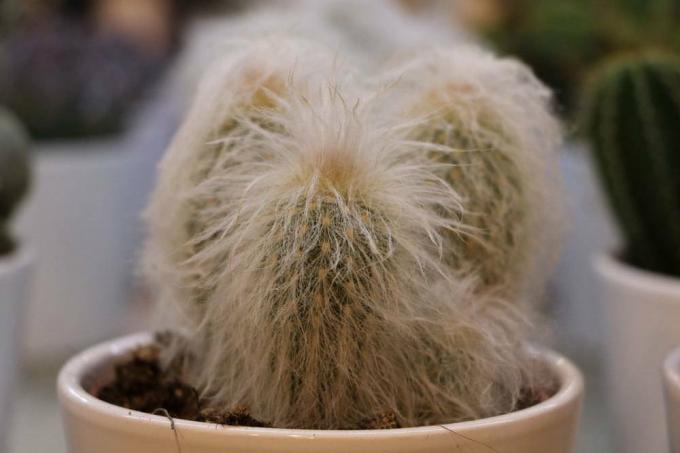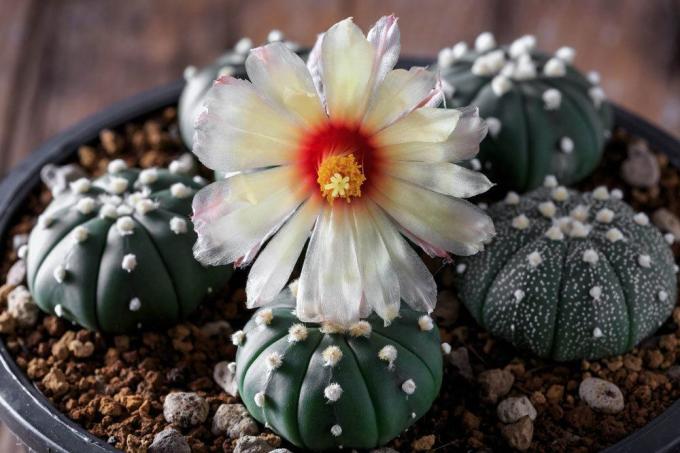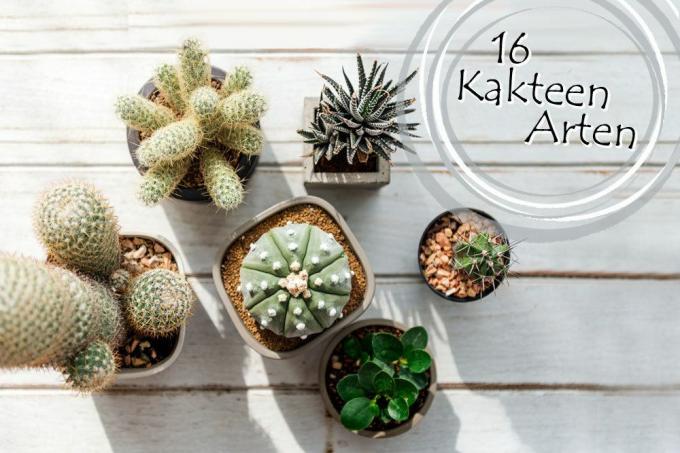
table of contents
- 16 beautiful and easy to care for cactus species
- Cactus species with B
- Cacti with F
- Cacti with G
- Types of H - O
- Cactus species from P - R
- Cactus species with S
- Types with W
- Cactus species with Z
The fascinating world of cacti offers a great wealth of different species. These differ in their appearance and in their needs in terms of care, temperature, substrate and location. Not all types of cacti can be cultivated easily on the windowsill, some only feel under glass or probably in a greenhouse. However, you can safely cultivate the cactus species on this list in your living room.
16 beautiful and easy to care for cactus species
The cactus species listed in this list are characterized by their uncomplicated demands. The species mentioned can be cultivated in the living room at home without any problems, provided that the location and the substrate are right.
Cactus species with B
Armed Cereus (Armatocereus mataranus)
The armed cereus is closely related to the cactus species Armatocereus balsaensis and Armatocereus rauhii, which are also very suitable for housing culture.
- Homeland: This cactus comes from Peru
- Growth habit: tree-shaped, branching columnar cactus
- Height / width: can be between three and nine meters high and up to 20 centimeters thick
- Thorns: up to ten centimeters long, arranged in clusters of three to eight pieces
- Blossom: white or red funnel-shaped flowers, up to nine centimeters long, night flowering
- Location: full sun and warm, also for partial shade
- Substrate: mineral, permeable
- Care: water regularly and vigorously, shower occasionally on hot days
- Winter storage: light and almost dry with temperatures between eight and 14 ° C
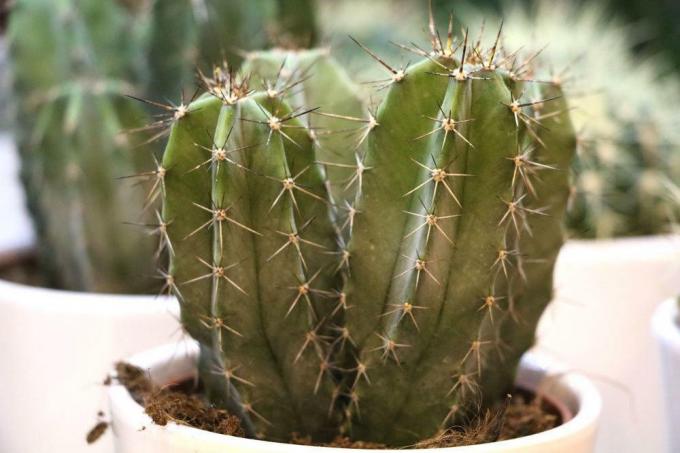
Bishop's cap (Astrophytum myriostigma var. nude)
This attractive cactus is one of the most famous species of cactus. It is also available in stores under the name star cactus. There are also numerous varieties or Cultivated forms.
- Home: Mexico
- Growth habit: spherical, cylindrical cactus when old
- Height / width: up to 60 centimeters high
- Thorns: none, but numerous white flakes all over the body
- Blossom: light yellow to yellow, shiny funnel-shaped flowers, between four and six centimeters long
- Location: sunny and warm, only exceptionally partially shaded
- Substrate: mineral and clayey, add plaster of paris
- Care: watering moderately but regularly
- Winter storage: light and dry at approx. 12 ° C
Cacti with F
Prickly pear (Opuntia ficus-indica)
The prickly pear is especially popular because of its tasty fruits. The prickly pears can often be bought in our supermarket. The plant also contains a number of active ingredients, including a. the psychedelic compound mescaline. You can cultivate the species in the living room, but it grows particularly well in the conservatory or greenhouse. Here, too, it can take on enormous proportions.
- Home: originally Central and South America, but now also occurs in Australia and the Mediterranean region
- Growth habit: cactus that grows from a shrub to tree-like shape with the ear-shaped shoots typical of opuntia
- Height / width: wild growing up to five meters high, individual links up to 50 centimeters long and 20 centimeters wide
- Thorns: rare
- Blossom: yellow to orange funnel-shaped flowers, up to seven centimeters long and ten centimeters wide
- Location: sunny and warm, preferably outdoors during the summer
- Substrate: well drained and loamy
- Care: water regularly and vigorously, spray occasionally
- Winter storage: light and dry at temperatures between five and ten degrees Celsius
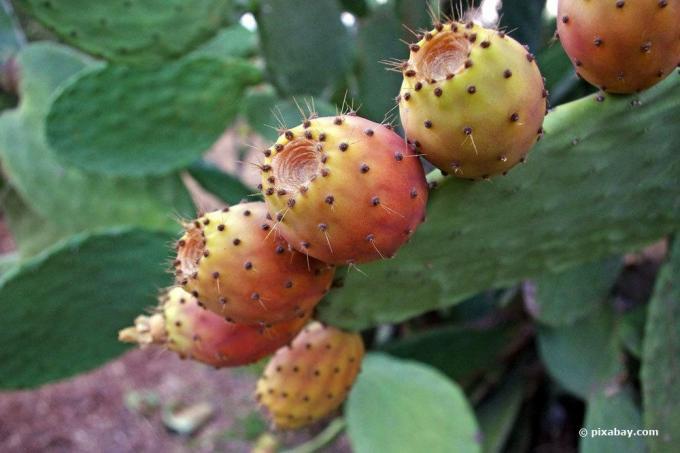
Rock cactus (Cereus peruvianus syn. Cereus uruguayensis)
The monstrous species (e. B. Cereus peruvianus var. monstrosus) known and loved. Because these are characterized by a particularly decorative appearance and are very easy to care for.
- Home: Brazil, Peru
- Growth habit: richly branching columnar cactus
- Height / Width: In their home, these cactus species grow up to three meters high and 18 centimeters wide.
- Thorns: between four and seven radial spines and one to three central spines, each up to approx. two inches long and brown
- Blossom: white funnel-shaped flowers, up to 16 centimeters long, night flowering
- Location: sunny to partially shaded, warm
- Substrate: nutrient-rich and humus
- Care: water regularly and vigorously
- Winter storage: light and not completely dry at around 12 ° C
Cacti with G
Pillar of gold (Notocactus leninghausii)
This pretty species, also known as the humpback cactus or golden ball cactus, is very popular. In the meantime, the genus Notocactus has been added to the genus Parodia, which is why the plant is sometimes sold under the botanical name Parodia leninghausii.
- Home: Brazil
- Growth form: spherical to columnar, often sprouting, characteristic is the crooked apex
- Height / Width: in old age up to one meter high and ten centimeters wide
- Thorns: up to 15 radial spines, up to one centimeter long, up to four central spines, up to four centimeters long, characteristic golden-yellow color
- Flower: yellow, funnel-shaped to bell-shaped, up to five centimeters long and six centimeters wide
- Location: sunny and warm, protect from direct sunlight
- Substrate: well drained, nutrient-rich, humic
- Care: water vigorously during the growing season
- Winter storage: light and not completely dry at temperatures between ten and 15 ° C

Old man's head (Cephalocereus senilis)
The characteristic white bristle hairs that surround the entire body of this cactus ‘are responsible for the common name.
- Home: Mexico
- Growth habit: branched columnar cactus
- Height / width: up to 15 meters high and 40 centimeters wide, but the slowly growing plant on the window sill rarely manages up to a meter in height
- Thorns: up to 30 white radial spines, up to 12 inches long and up to five yellowish central spines, up to five inches long
- Blossom: white-yellowish funnel-shaped flowers, up to ten centimeters long and eight centimeters wide, night blooming
- Location: very sunny and warm, preferably under glass
- Substrate: well drained and slightly calcareous
- Care: water regularly but very sparingly. Let the substrate dry out occasionally
- Winter storage: light and not completely dry at ten to 15 ° C
Types of H - O
Rabbit's ear cactus (Opuntia microdasys)
There is a reason why it bears its funny name, after all it is one of the most visually striking cactus species. The shoots are - typical of Opuntia - thickened ear-shaped. However, be careful when handling this plant, because the small glochid tufts stick into the skin in a flash and are difficult to remove again.
- Home: Mexico
- Growth habit: shrubby
- Height / width: up to 60 centimeters high, individual links up to 15 centimeters long
- Thorns: none, but numerous yellow glochids
- Flower: yellow funnel-shaped flowers, up to five centimeters long and just as wide
- Location: sunny and warm, preferably outdoors during the summer months
- Substrate: well drained and loamy
- Care: water regularly and vigorously, spray occasionally
- Winter storage: light and dry at temperatures between five and ten degrees Celsius
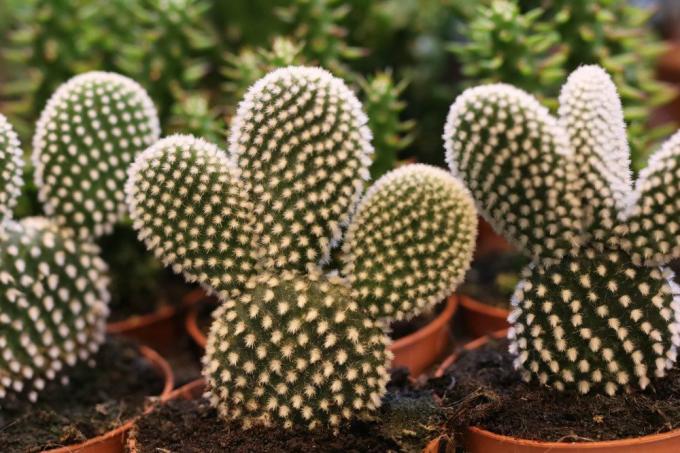
Coral cactus (Hatiora salicornioides)
This attractive, bushy growing cactus with club-shaped shoots is also known as Club cactus available. It belongs to the very slow growing cactus species.
- Home: Brazil
- Growth habit: bushy, epiphytic (epiphyte)
- Height / width: up to one meter long shoots, consisting of many individual links up to three centimeters long
- Thorns: none, instead white bristles arise from the areoles
- Flower: yellow funnel-shaped flowers, up to 1.5 centimeters long
- Location: partially shaded and warm
- Substrate: cactus soil enriched with peat
- Maintenance: regular but moderate
- Winter storage: light at about 10 ° C, water sparingly

10. Easter cactus (Hatiora gaertneri)
This very easy to care for and popular cactus is also often sold under the old botanical name Rhipsalidopsis gaertneri. There are numerous hybrid forms.
- Home: Brazil
- Growth habit: shrubby, mostly overhanging and forked when old
- Height / width: up to 2.5 centimeters wide and seven centimeters long leaf segments
- Thorns: up to 12 bristly thorns per areole
- Blossom: scarlet funnel-shaped flowers, up to 7.5 centimeters long
- Location: thrives in almost any location from full sun to partial shade
- Substrate: well drained, nutrient-rich, humic
- Care: water vigorously and regularly during the summer months
- Wintering: not completely dry at around ten degrees Celsius
Cactus species from P - R
Whip Cactus (Aporocactus flagelliformis)
- Home: Mexico
- Growth form: upright to overhanging, branching epiphyte (epiphyte)
- Height / Width: Shoots up to 150 centimeters long and two centimeters thick
- Thorns: up to 20 initially reddish, later brown thorns
- Flower: pink or red, up to ten centimeters long
- Location: partial shade, as airy as possible
- Substrate: rich in humus, well drained
- Care: no waterlogging, water every two to three weeks, high humidity, fertilize once a month
- Winter storage: light and at least 12 ° C
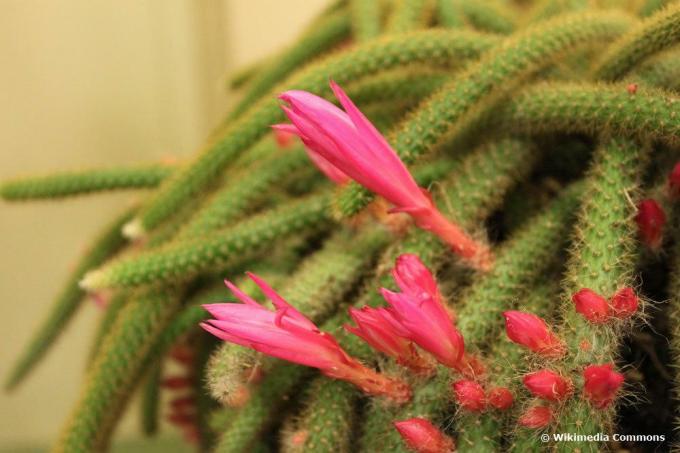
Rod cactus (Rhipsalis pilocarpa)
At first glance, the rod cactus is not necessarily one of the typical types of cactus. This variety grows like a bush and forms numerous branches.
- Home: Brazil
- Growth habit: shrub-like
- Height / Width: The hanging shoots are up to 12 centimeters long and six millimeters thick.
- Thorns: up to ten bristly hair thorns
- Blossom: white to yellowish-white radial flowers, up to 2.5 centimeters wide, appear in winter
- Location: partially shaded, no direct sunlight
- Substrate: sandy with peat
- Care: preferably water with rainwater, fertilize with flower fertilizer every 14 days
- Winter storage: between the beginning of September and the end of October water less, no further hibernation
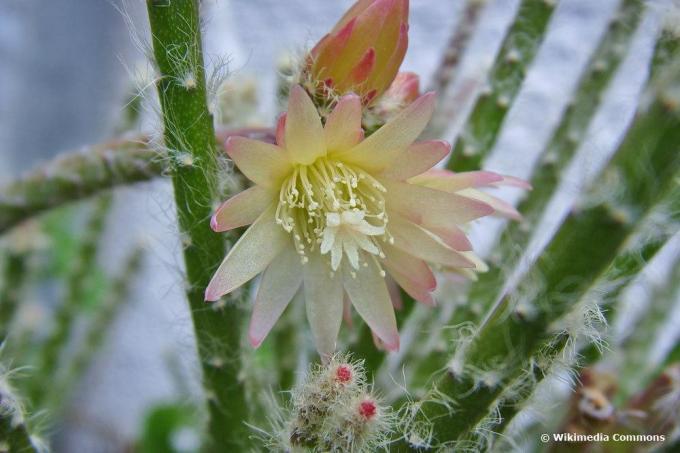
Cactus species with S
Mother-in-law (Echinocactus grusonii)
The species, also known as the mother-in-law, is probably one of the best-known and most popular cactus species. It can then become quite wide with age.
- Home: Mexico
- Growth form: spherical, often short-cylinder when old
- Height / width: up to 150 centimeters high and 80 centimeters wide
- Thorns: between eight to ten radial spines, inclined and up to three centimeters long, three to five central spines, curved and up to two inches long, all pale yellowish to cream-colored colored
- Flower: yellow funnel-shaped flowers, up to six centimeters long, rarely appear in culture
- Location: sunny and warm, preferably outdoors during the summer months
- Substrate: permeable
- Care: always water very sparingly, but never let it dry out completely
- Winter storage: light, dry, not below ten degrees Celsius

Sea Urchin Cactus (Astrophytum asterias)
There are other types of cactus that are also known as "sea urchin cactus". These include, for example, the various species from the genus Echinopsis.
- Home: Mexico, USA
- Growth habit: spherical cactus with a pressed, bluish-green body
- Height / width: up to six inches high and ten inches wide
- Thorns: none, instead thick, white felted areoles
- Flower: yellow funnel-shaped flowers, up to three centimeters long
- Location: sunny and warm, only exceptionally partially shaded
- Substrate: mineral and clay-rich, ideally add a little gypsum
- Care: watering moderately but regularly
- Winter storage: light and dry at approx. 12 ° C
Types with W
Wax Torch Cactus (Cereus spegazzinii) Cereus spegazzinii
This cactus belongs to the cactus species with bizarre-looking growth forms, which, however, have a very decorative effect. Beautiful Cristat forms are often available in stores, which are then usually offered under their old botanical name Monvillea spegazzinii. These plants are also suitable for living room culture, but less for the windowsill because of their expansive shoots. A climbing aid is an advantage here.
- Home: Argentina, Paraguay
- Growth habit: climbing, shrubby or prostrate cactus
- Height / width: shoots are up to two meters long and two centimeters wide
- Thorns: between three and five dark brown, up to four millimeters short radial spines, occasional central spines up to 15 millimeters in length
- Blossom: white to pink funnel-shaped flowers, up to 13 centimeters long
- Location: sunny and warm, also possible in partial shade
- Substrate: well drained and humus
- Care: water regularly and vigorously, always keep the substrate slightly moist, fertilize monthly between April and August
- Winter storage: light and not completely dry at approx. ten degrees Celsius
Christmas cactus (Schlumbergera species)
The different Schlumbergera species as well as their hybrid forms are all called "Christmas cacti" referred to, although originally only the species Schlumbergera truncata and their hybrids were so named became.
- Home: Brazil
- Growth form: bushy to shrubby, heavily branching, overhanging when old
- Height / width: The leaf-like individual links are up to six inches long and three inches wide. The individual shoots can be up to a meter long.
- Thorns: usually none
- Blossom: red, purple, white-pink or pale-orange, depending on the species up to nine centimeters long, appear in December
- Location: sunny to partially shaded, warm
- Substrate: rich in humus, acidic
- Care: Always keep the substrate moist, ideally use rainwater for watering
- Overwintering: no hibernation
Cactus species with Z
Pygmy cactus (Echinopsis chamaecereus)
These cacti are also known by their common names, Würstelkaktus or cactus cactus, which refer to their characteristic appearance. The pretty minis are also often available in stores under their old botanical names Chamaecereus silvestrii or Lobivia silvestrii. A variety of this species, mostly Chamaecereus silvestrii var. called aurea, is one chlorophyllless mutation. It is characterized by yellow to orange-colored shoots, which is why it is often offered as a banana cactus. Due to the lack of chlorophyll, this plant can only survive grafted.
- Home: Argentina
- Growth habit: cylindrically growing cactus, sprouts, partly prostrate
- Height / Width: Shoots can be up to ten centimeters long
- Thorns: between 10 to 15 radial spines, up to two millimeters long, no central spines
- Flower: vermilion funnel-shaped flowers, between five and seven centimeters long, appear laterally
- Location: sunny and warm, preferably outdoors during the summer months
- Substrate: nutrient-rich, mineral, slightly acidic
- Care: water abundantly during the growing season, but avoid waterlogging
- Winter storage: light and dry at approx. ten degrees Celsius




